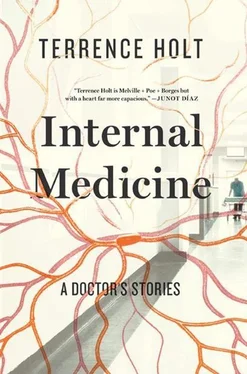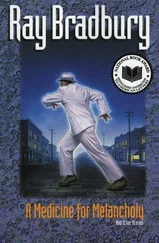“He’s complaining of chest pain. Ten out of ten.”
“Crap,” I said. The nurse looked at me. “Get an EKG.”
My vague hope vanished entirely ten minutes later as I watched the red graph paper emerge from the side of the box. The squiggle on it looked better than the initial set from the ER, but that was only because the ectopy was gone. What was there instead — Mr. Gillet’s souvenir of the activities of the afternoon — were T-wave inversions marching across his precordium. This is not good. T-wave inversions generally signify heart muscle that isn’t getting oxygen. What I was seeing here suggested that his LAD — a major artery supplying blood to the heart’s strongest muscle — was about to choke off. I looked up at the nurse. She had been reading the strip as well — upside down, as cardiology nurses can.
“You gonna move him?” she asked.
“Yeah.”
“Write me some orders.”
“I’ll write you orders. Just get him to the Unit. Quickly,” I added, with a backward glance through the door of fourteen. Gillet’s beaked face lay still in its silver cage. I scratched out a set of orders and turned to the next disaster.
I DIDN’T GIVE GILLET much thought the rest of the evening, beyond seeing him settled in the CCU, and getting him scheduled as an add-on for the Cath Lab the next day. Around two in the morning the three of us — my partner Sasha, the intern Jeff, and I — were gathered at one end of the long counter, pushing stacks of paper around and trying to count up the score. We were on admission twelve for the day, we decided, but couldn’t remember who was up next. I was digging in my pockets for a coin to flip when my pager went off. I swore as I tugged it from my belt, expecting to find yet again the number for the ER. I found instead the number for the CCU, followed by “911.” At that moment the overhead paging system called a code in the CCU. The three of us ran.
It was perhaps thirty yards to the CCU, but by the time we got there three of the six nurses on shift were in Gillet’s room, one at the head squeezing oxygen through a bag-valve mask, another compressing his chest, a third readying the crash cart. I had a moment’s awareness that something was unusual — the whole thing looked too emptily staged, some kind of diorama in the Museum of Human Misery — but the scene only appeared that way for an instant and then we were in it and perspective fell apart in a surge of activity that picked us all up on its back and hurried us on.
Sasha and I had never made any formal arrangement about who did what in a code. I was the first one on the far side of the bed and started feeling the groin for a pulse. It was faint, driven solely by the nurse’s compressions, but clear enough. I grabbed a finder syringe from the tray a nurse held out to me and plunged it in. Nothing. Pull back, change angle, feel for the pulse again and drive. Needle ground against bone. Again, and on this pass I saw the flash in the syringe, flung it aside and put a thumb over the welling blood while reaching for the wire. The nurse had it out already, handle turned toward me. It threaded the vein without resistance.
I had the catheter in place a minute or two later, met at each step in the process by the right item held out at the right time. No one spoke a word.
On the other side of the bed, Sasha stood with her arms folded across her chest, nodding at two nurses in turn as they pushed drugs, placed pads on the chest, and warmed up the defibrillator. Her eyes were on the monitor overhead, where green light drew lazy lines across the screen. At some point in the proceedings Anesthesia had shown up and slipped an endotracheal tube down Gillet’s throat; respiratory therapy was wheeling a ventilator to the head of the bed, looping tubing through the bars of the halo and cursing at it.
“Hold compressions,” Sasha said. The nurse stopped pushing on the chest. I saw for the first time that the halo was supported by a broad sheet of plastic backed with sheepskin that covered the upper half of the chest: the nurse had to get her hands underneath it to press; with each compression Gillet’s head bobbed up and down, up and down. He was out, his eyes blank at the ceiling. The nurse at my elbow was hooking up the ports of my catheter, pushing one of the blunt syringes of epinephrine. We were all staring at the monitor above the bed, the long horizontal drift of asystole. As the second amp of atropine ran in, the lines all leapt to life, frantic peaks filling the screen.
“V-fib,” a nurse said quietly.
“Paddles,” Sasha replied in the same voice, taking the offered handgrips of the defibrillator from the nurse as she spoke.
“Clear,” she said quietly, and thumbed the button.
David Gillet’s body rose from the mattress, hung for a moment, collapsed. On the screen we saw scrambled green light settle for a moment, a rhythm emerge. Then the peaked lines consolidated into a high picket fence.
“V-tach,” said the nurse, and turned up the power on the defibrillator.
“Clear,” said Sasha. The body arched and fell again.
It went on for twelve more minutes (we knew this later, as we reviewed the printed strips of telemetry paper, trying to reconstruct what had gone on), Gillet’s heart flying through one arrhythmia after another. Each time we responded it would settle briefly into sinus rhythm before flinging out again into some lethal variation, until finally, after two grams of magnesium sulfate and another round of shocks, it found a rhythm and held it through another flurry of activity when his systolics dropped to the sixties, then rallied on a minimal infusion of dopamine. And through all of this, as the atmosphere in the room maintained its eerie calm, the nurses kept up their surreal economy of gesture, and Sasha intoned the ritual of the ACLS algorithm, I felt my own adrenaline surging through the night’s fatigue in an approach to exultation. It was almost beautiful.
This, I thought as we left the room, the lines on the monitor dancing their steady dance, the ventilator measuring breath and time to its own slower rhythm, this is what a code should be. A clean thing. A beautiful thing. The patient hadn’t died.
THE REST OF THE NIGHT was anticlimax, of course. There was a note to write (there is always a note to write), for which we had to puzzle some time over the strips churned out by the telemetry system, the notes scribbled on a paper towel recording what drugs had been given when, the values called over the phone from Core Lab and written in black marker on the leg of a nurse’s scrubs. There was the call to the wife: I had to temper my enthusiasm as I searched for words to use when calling from the CCU at 2:35 in the morning. She took the news well enough, asked if I thought she needed to come now. I assured her he was stable. I assured her everything was under control; I had anticipated the code, I realized, when I moved him to the CCU. He was in the safest possible place. “In the morning, then,” she said softly.
“In the morning,” I agreed, and turned to the call room at last, where I spent perhaps forty-five minutes on my back, replaying the code against the springs of the empty bunk above me, until my pager went off again and this time it was the ER. And then around five another code on 4 West, where we found a man bleeding from a ruptured arterial graft and I had to threaten him with death if he did not hold still while I put yet another catheter in yet another groin, and this time there were fourteen nurses in the room, all shouting at once, so that I had to bellow over them to be heard as I requested, repeatedly, the proper catheter kit, something big enough to pour in fluid as fast as he was losing it. The patient was alive when I saw him last, a scared and tousled surgery intern kneeling right on top of him to hold pressure as the entire ungainly assemblage — patient, intern, and tree of IV bags — wheeled out the door to the OR. Back to normal life, I said to Sasha as we trudged back to the cardiology ward. Whether she knew what I was talking about I couldn’t say, and didn’t really care. I was still warmed by a vague sense of something right having happened. Mr. Gillet had coded, coded beautifully, and he had survived. We had done everything right.
Читать дальше












